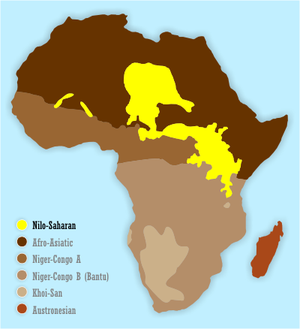| Nilo-Saharan | |
|---|---|
| (disputed) | |
| Geographic distribution | Central Africa, north-central Africa and East Africa |
Native speakers | ca. 70 million for all branches listed below.[1] |
| Linguistic classification | Proposed language family |
| Proto-language | Proto-Nilo-Saharan |
| Subdivisions | |
| Language codes | |
| ISO 639-2 / 5 | ssa |
| Glottolog | None |
 Distribution of Nilo-Saharan languages (in yellow) | |
The Nilo-Saharan languages are a proposed family of around 210 African languages[1] spoken by somewhere around 70 million speakers,[1] mainly in the upper parts of the Chari and Nile rivers, including historic Nubia, north of where the two tributaries of the Nile meet. The languages extend through 17 nations in the northern half of Africa: from Algeria to Benin in the west; from Libya to the Democratic Republic of the Congo in the centre; and from Egypt to Tanzania in the east.
As indicated by its hyphenated name, Nilo-Saharan is a family of the African interior, including the greater Nile Basin and the Central Sahara Desert. Eight of its proposed constituent divisions (excluding Kunama, Kuliak, and Songhay) are found in the modern countries of Sudan and South Sudan, through which the Nile River flows.
In his book The Languages of Africa (1963), Joseph Greenberg named the group and argued it was a genetic family. It contained all the languages that were not included in the Niger–Congo, Afroasiatic or Khoisan families. Although some linguists have referred to the phylum as "Greenberg's wastebasket", into which he placed all the otherwise unaffiliated non-click languages of Africa,[2][3] other specialists in the field have accepted it as a working hypothesis since Greenberg's classification.[4] Linguists accept that it is a challenging proposal to demonstrate but contend that it looks more promising the more work is done.[5][6][7]
Some of the constituent groups of Nilo-Saharan are estimated to predate the African neolithic. For example, the unity of Eastern Sudanic is estimated to date to at least the 5th millennium BC.[8] Nilo-Saharan genetic unity would thus be much older still and date to the late Upper Paleolithic. The earliest written language associated with the Nilo-Saharan family is Old Nubian, one of the oldest written African languages, attested in writing from the 8th to the 15th century AD.
This larger classification system is not accepted by all linguists, however. Glottolog (2013), for example, a publication of the Max Planck Institute in Germany, does not recognise the unity of the Nilo-Saharan family or even of the Eastern Sudanic branch; Georgiy Starostin (2016) likewise does not accept a relationship between the branches of Nilo-Saharan, though he leaves open the possibility that some of them may prove to be related to each other once the necessary reconstructive work is done. According to Güldemann (2018), "the current state of research is not sufficient to prove the Nilo-Saharan hypothesis."[9]
- ^ a b c "Nilo-Saharan; Ethnologue". Archived from the original on 2023-03-09. Retrieved 2023-08-06.
- ^ Campbell, Lyle; Mixco, Mauricio J. (2007). A Glossary of Historical Linguistics. University of Utah Press. ISBN 978-0-87480-892-6.
- ^ Matthews, P. H. (2007). Oxford Concise Dictionary of Linguistics (2nd ed.). Oxford. ISBN 978-0-19-920272-0.
{{cite book}}: CS1 maint: location missing publisher (link), - ^ Blench, Roger & Lameen Souag. m.s. Saharan and Songhay form a branch of Nilo-Saharan Archived 2016-03-27 at the Wayback Machine.
- ^ Dimmendaal, Gerrit J. (1992). "Nilo-Saharan Languages". International Encyclopedia of Linguistics. Vol. 3. Oxford. pp. 100–104. ISBN 0-19-505196-3.
{{cite book}}: CS1 maint: location missing publisher (link) - ^ Bender, M. Lionel (2000). "Nilo-Saharan". African Languages, An Introduction. Cambridge: Cambridge University Press. pp. 43–73. ISBN 0-521-66178-1.
- ^ Blench, Roger; Ahland, Colleen (2010). The Classification of Gumuz and Koman Languages. Language Isolates in Africa workshop, Lyons, December 4. Archived from the original on March 16, 2012. Retrieved September 5, 2011.
- ^ Clark, John Desmond (1984). From Hunters to Farmers: The Causes and Consequences of Food Production in Africa. University of California Press. p. 31. ISBN 0-520-04574-2.
- ^ Güldemann, Tom (2018). "Historical linguistics and genealogical language classification in Africa". In Güldemann, Tom (ed.). The Languages and Linguistics of Africa. The World of Linguistics series. Vol. 11. Berlin: De Gruyter Mouton. pp. 299–308. doi:10.1515/9783110421668-002. ISBN 978-3-11-042606-9. S2CID 133888593.